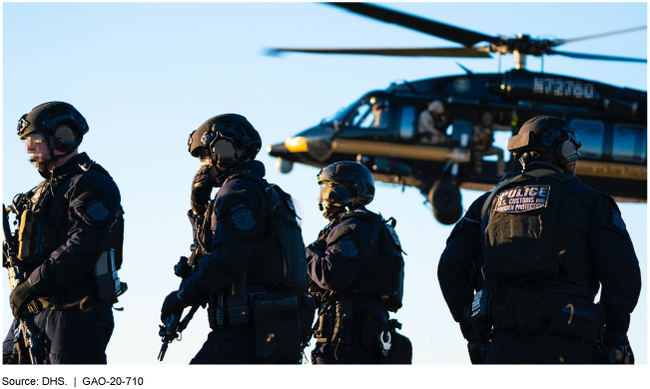Federal Tactical Teams: Characteristics, Training, Deployments, and Inventory
Fast Facts
Many federal agencies have specialized law enforcement teams trained and equipped for critical incidents such as hostage rescue. This report describes these federal tactical teams, including their deployments and equipment.
We identified 25 teams within the Departments of Homeland Security, Justice, and elsewhere.
Deployments per team from FY 2015-19 ranged from 0 to over 5,000. Sixteen teams reported deployments related to nationwide civil unrest and protests in May and June 2020.
Teams reported having various items, such as firearms, armored personnel carriers, aircraft, and specialized munitions, such as rubber bullets and tear gas.
The U.S. Customs and Border Protection's Special Response Team

Highlights
What GAO Found
Within the executive branch, GAO identified 25 federal tactical teams, and the characteristics of these teams varied. The 25 tactical teams were across 18 agencies, such as agencies within the Departments of Homeland Security, Justice, Energy, and the Interior. The number of reported team members per team ranged from two to 1,099. More than half (16 of 25) of the teams reported that they are composed of team members working for the team on a collateral basis. Most teams (17 of 25) had multiple units across various locations.
Photos of Federal Tactical Teams in Action

Tactical teams generally followed a similar training process, with initial training, specialty training, and ongoing training requirements. Nearly all teams (24 of 25) reported that new team members complete an initial tactical training course, which ranged from 1 week to 10 months. For example, potential new team members of the Federal Bureau of Investigation's Hostage Rescue Team complete a 10-month initial training that includes courses on firearms; helicopter operations; and surveillance, among others. Nearly all teams (24 of 25) reported offering specialized training to some team members, such as in sniper operations and breaching. Nearly all teams (24 of 25) also reported having ongoing training requirements, ranging from 40 hours per year to over 400 hours per year.
The number and types of deployments varied across the 25 tactical teams for fiscal years 2015 through 2019. The number of reported deployments per tactical team during this time period ranged from 0 to over 5,000. Teams conducted different types of deployments, but some types were common among teams, such as:
- supporting operations of other law enforcement entities, such as other federal, state, and local law enforcement (16 of 25);
- providing protection details for high-profile individuals (15 of 25);
- responding to or providing security at civil disturbances, such as protests (13 of 25); and
- serving high-risk search and arrest warrants (11 of 25).
Four teams reported that they had deployed in response to the Coronavirus 2019 (COVID-19) pandemic, and 16 teams reported deployments related to nationwide civil unrest and protests in May and June 2020.
Tactical teams reported having various types of firearms, tactical equipment, and tactical vehicles in their inventories. Team members generally have a standard set of firearms (e.g., a pistol, a backup pistol, and a rifle), but some may also have specialized firearms (e.g., a shotgun designed to breach doors). Tactical teams also have a variety of tactical equipment, such as night vision devices to maintain surveillance of suspects or tactical robots that can go into locations to obtain audio and video information when team members cannot safely enter those locations. Tactical teams may also have tactical vehicles, such as manned aircraft (e.g., helicopters) and armored vehicles to patrol locations. The figure below identifies the number of tactical teams that reported having such items in their inventories.
Number of Federal Tactical Teams That Reported Having Firearms, Tactical Equipment, and Tactical Vehicles in Their Inventories, as of January 2020

Appendix I of the report provides details on each of the 25 tactical teams, such as each team's mission; staffing; types and frequency of training; and number and types of deployments from fiscal years 2015 through 2019. This is a public version of a sensitive report issued in August 2020. Information deemed to be sensitive by the agencies in this review, such as the quantities of firearms, tactical equipment, and tactical vehicles in team inventories, has been omitted from this report.
Why GAO Did This Study
Many federal agencies employ law enforcement officers to carry out the agency's law enforcement mission and maintain the security of federal property, employees, and the public. Some of these agencies have specialized law enforcement teams—referred to as federal tactical teams in this report—whose members are selected, trained, equipped, and assigned to prevent and resolve critical incidents involving a public safety threat that their agency's traditional law enforcement may not otherwise have the capability to resolve.
This report provides information on the (1) federal tactical teams and their characteristics; (2) training team members receive; (3) deployments of such teams from fiscal years 2015 through 2019; and (4) firearms, tactical equipment, and tactical vehicles in team inventories, as of January 2020.
To identify federal tactical teams, GAO contacted executive branch agencies with at least 50 federal law enforcement officers. GAO administered a standardized questionnaire and data collection instrument to the identified teams to gather information on team missions, staffing, training, deployments, and inventories. GAO reviewed team documents, such as standard operating procedures, and interviewed agency officials. GAO collected descriptive information on reported deployments as of June 2020 in response to COVID-19 and nationwide civil unrest, which were ongoing during the review. GAO incorporated agency technical comments as appropriate.
For more information, contact Gretta L. Goodwin at (202) 512-8777 or goodwing@gao.gov.
